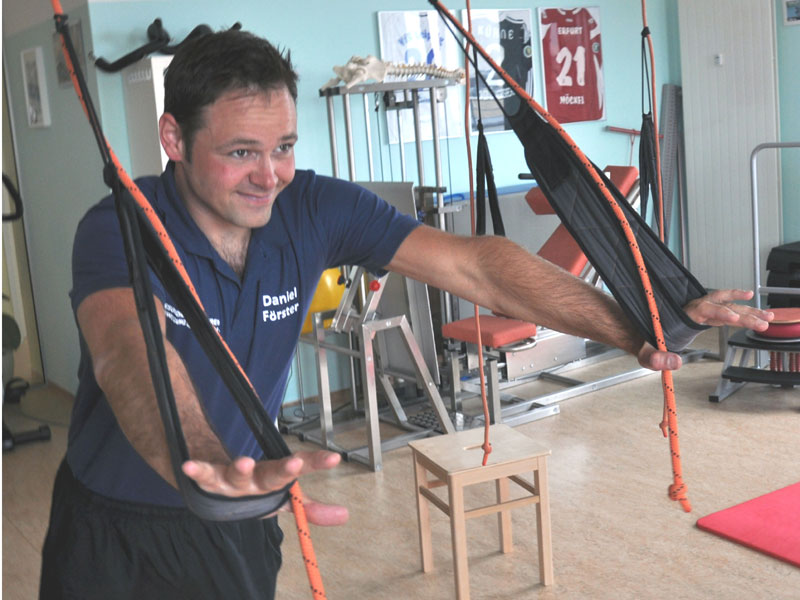Summer is slackline time.
Once you've caught the slackline bug, you can't imagine it without the exhilarating feeling of mastering the tensioning belt. On the slackline, you can train physical skills that we often neglect in everyday life, while having fun and enjoying it.

Trying to find and maintain balance trains coordination, the sense of balance and, above all, the small muscles located close to the joints, which are otherwise so difficult to train.
A physiotherapist can confirm from daily practice how important these are in combating many types of muscle, joint and back pain.
Have courage, because slacklining enriches your life significantly and is easier to learn than it looks.
Technique and Application of Slackline
 The leash is a tensioning belt made of sturdy nylon material and ideally GS or TÜV tested. This can be stretched between two points at different heights. You can balance on it, practice on it and, if you're ambitious, even turn and jump on it. The die-hard "slacker" then naturally calls it "slacking".
The leash is a tensioning belt made of sturdy nylon material and ideally GS or TÜV tested. This can be stretched between two points at different heights. You can balance on it, practice on it and, if you're ambitious, even turn and jump on it. The die-hard "slacker" then naturally calls it "slacking".
The swinging motion of the wobbly slack line is what makes it so appealing. The difficulty changes depending on the width and tension, so that even inexperienced people can easily get to grips with the subject.
Slackline for Beginners
As a slackline beginner, you generally start with a beginner set .
First of all, such a set requires a slackline - this should be 15-20 m long in order to be able to react flexibly to trees that are at different distances from each other. With a width of 5 cm, occasional slackers or families with small children are well equipped. If you like, you can switch to thinner lines of 3.5 cm or even 2.5 cm straight away or later.
 As a counterpole , there is a ratchet into which the slackline can be inserted and thus “ratcheted” for tension.
As a counterpole , there is a ratchet into which the slackline can be inserted and thus “ratcheted” for tension.
Large loops are placed around the opposite trees. Using two small forged metal loops - also called shackles - which can be closed with a screw, the loops around the trees are securely connected to the slackline from one tree and to the ratchet from the other. Now adjust everything to the right height and tighten or loosen the belt as desired using the ratchet.
Now you can get started.
In addition to your own safety, you should also think about protecting nature and consider buying a tree protector . These are two slightly wider loops of tape that are placed around the tree under the lines to protect the tree trunk.
A cheap duffel bag , in which everything can be conveniently stored and tidied, rounds things off. This means you are mobile and have everything to hand at all times.
To get started, the price for a beginner's set is between 69 and 199 euros including VAT.
slackline attachment
Traditionally, the strap is stretched between two trees, but there are now other possibilities : 
- between a tree and a ground anchor , ground screw anchor or concrete anchor
- without any trees, outdoors between two ground anchors, ground screw anchors or concrete anchors
- on slackline frames, the so-called slack frames or slack trainers, outdoors or indoors
- using special solutions for school sports in gyms or training grounds
Slackline attachment without trees
Without trees, you actually only need two relatively stable fixed points between which you can stretch. If you don't have anything here, there are so-called ground anchors, ground screw anchors or concrete anchors . These are either buried as ground anchors, drilled into the ground as ground screw anchors or firmly set in concrete as concrete anchors.
Slackline attachment to a tree
Here you only need another anchor point next to the tree. This can be a house wall or a corresponding anchor as described above. Please note that when attaching to the wall, a high tensile force is created and the fastening solution should be very stable.
Slackline frames - Slackline Rack, Slackframe
 In addition to trees, there are also frames in which you can set up slacklines. They are also called slack frames, slackline racks or slack trainers . We differentiate between frames for leisure use and frames for slackline therapy.
In addition to trees, there are also frames in which you can set up slacklines. They are also called slack frames, slackline racks or slack trainers . We differentiate between frames for leisure use and frames for slackline therapy.
slackline exercises
As a beginner, standing and walking on the line is enough practice. It automatically trains coordination, deep muscles, balance and the sensorimotor system. The great thing is that progress doesn't take long. After just a few times on the slackline, you'll be able to walk a few steps or even the whole distance.
As an experienced person, many possibilities open up to keep the topic exciting – here are just a few:
- With additional games on the line, the challenge increases. Why not play ball or throw the Frisbee from above?
- You can stretch the line higher or over the water or even over the mountain gorge.
- Narrower lines increase the challenge, special fitness lines can be tightened more for jumps and turns
- Small jumps and turns give the experienced adrenaline and somersaults and spectacular elements give the same to the slackline professionals
But don't worry if you can't find yourself here. For most people, simply balancing back and forth on the line will always be fun and exciting.
Slackline exercises in physiotherapy
In physiotherapy, the use of tightly stretched straps is referred to as slackline therapy . This should be carried out by a trained physiotherapist and aims to use the physical effects of the vibrations to help recover from injuries. The focus of the exercises is on static to slowly dynamic exercises and the therapeutic use of slacklines requires a special setup.
slackline therapy
 Therapeutic use of the slackline involves using the vibrations generated by the tensioning belt for medical training therapy through certain exercises. This requires a special structure that allows the belts to be pulled very tightly and also allows several belts to be pulled next to each other and on top of each other to allow physically handicapped people to practice safely. The corresponding slackline frames are also called slack trainers.
Therapeutic use of the slackline involves using the vibrations generated by the tensioning belt for medical training therapy through certain exercises. This requires a special structure that allows the belts to be pulled very tightly and also allows several belts to be pulled next to each other and on top of each other to allow physically handicapped people to practice safely. The corresponding slackline frames are also called slack trainers.
The best way to learn slackline therapy exercises is in a personal and professionally guided course , which is conducted by an experienced physiotherapist. In the course offering at the AMS Academy, we recommend the courses STT 2 and STT 3 .
slackline advice
We are happy to advise you on everything from choosing the right slackline set to the first steps and training in slackline therapy.
Write us an email or call us at Tel: 089 - 21765202
Or you can simply browse through the slackline sets and see if you can find the right one.
The REHAPE team wishes you lots of fun and
Yours, Stefan Ernst




Leave a comment
This site is protected by hCaptcha and the hCaptcha Privacy Policy and Terms of Service apply.